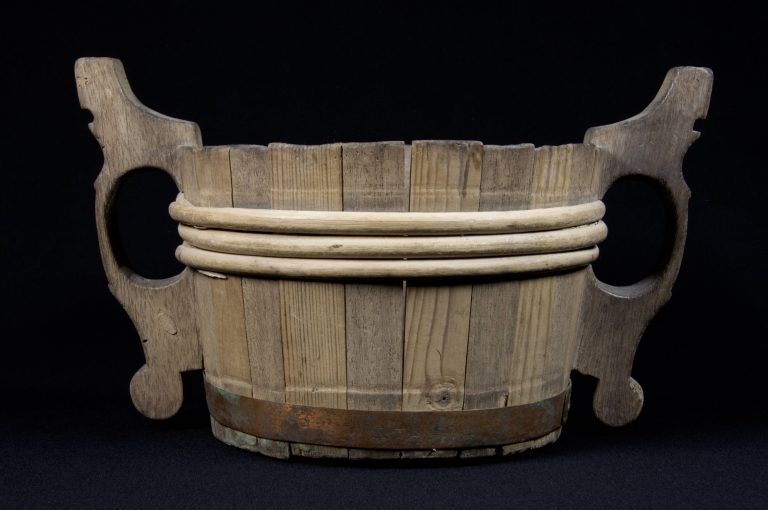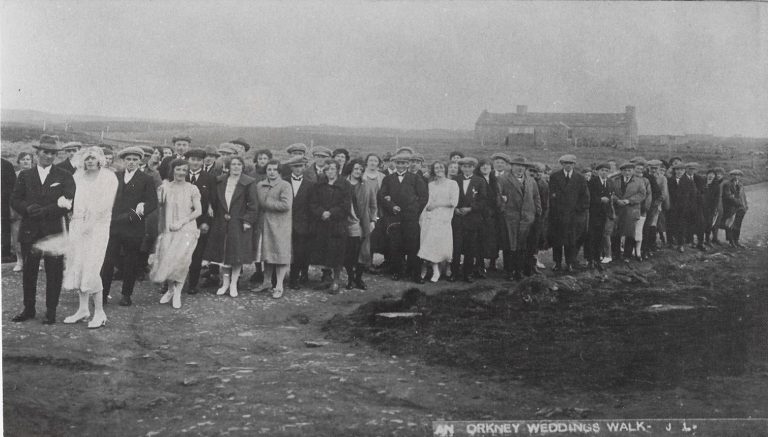The tradition behind the Orkney Cog
In the past all those important life events, birth, marriage and death, were steeped in rituals. If things were not done in a certain way, then that could have an impact on the future success and happiness of that person or couple. All the rituals that went with a marriage are too many to cover in detail, but the one that has continued right up to the present day is the Bride’s Cog. This heady mixture of sweet, spiced ale and spirits is passed around the wedding guests, who drink from a communal vessel. But why? Well, let me explain.

An Orkney wedding had to be held with a growing moon and a flowing tide, if the couple are to enjoy a plentiful life. The month of May was avoided as being unlucky. The favoured day to be married on was a Thursday, with Tuesday or Sunday being second best. The wedding party arrived at the bride’s house before noon, and they set off on the ‘wedding walk’ to the kirk. The groom took the lead, arm in arm with the best-maid (bride’s maid), while the bride came behind with the best-man. Next came family members, in pairs, followed by couples. Unmarried guests and children took up the rear. The ones at the very end were called the ’tail-sweepers’, and had to drag a heather broom behind them, to clear away traces of their footsteps. This would have been to confuse the trows (fairy folk). Guns were intermittently fired over the party as well, to scare away the trows.

After the wedding had taken place the wedding party walked back to the bride’s house, where a feast had been prepared. This time the newlyweds led the way, with the best-maid and best-man behind them. On arriving at the house, they were met by an old couple, chosen from among the eldest people in the parish and who had a reputation of being kind and ‘open-handed’ (generous). The old man, called the ‘mester-hoosal’ (master of the household) offered them a cog to drink from. Cogs are wooden, bucket-like vessels made of staves, like a barrel (the word ‘kagi’ is Old Norse and has the same derivation as the word ‘keg’). Then the ‘hansel-wife’ (gift-giving woman) would offer food to the party. She would then hand the smallest baby in the parish to the bride. This ‘’hansel-bairn’ was watched carefully, because if it lifted its left leg first then the bride would have mostly boys, right leg meant mostly girls.
The feast was a communal affair, with meat, bannocks and ale brought by neighbours, as well as being provided by the families of the couple. At a time when most Orcadians lived on a diet of barley and dried fish, this was a rare opportunity to eat meat. Ale cogs were shared by a group of six, who also shared a communal wooden trough filled with food. Then the dancing started, which went on into the small hours of the next day.
At the end of the wedding came the bride’s cog. This was made of ale, sweetened and spices, and with spirits added. Whisky was made for personal consumption in the days before you had to have a licence to do so. The most common and popular spirit was gin, smuggled mostly from Holland. Recipes vary from family to family and are often a secret. The point of the bride’s cog was to finish off anyone who was still standing at the end of the evening. Unless everyone was drunk then it was not considered a good wedding. The bride and groom carried the cog, being careful to follow the course of the sun (clockwise) and offer the cog to all the guests. The cog was made from two different colours of wood, dark and light, unlike the ale cogs that were the same colour. Cogs are either ‘lugged’, with handles like that on a mug, or ‘horned’, with handles that were a continuation of a stave and stick upwards. Early cogs had three horns, so that it could be passed easier.

Sometimes pancakes were soaked in the heady mix and a small ladle or spoon was provided to fish out a piece to eat. One joker on Sanday slipped a woollen mitten into the cog and an old man spent some time trying to eat it before throwing it on the floor in disgust. Legends of false teeth being slipped in, for a laugh, are told, but whether that ever happened or not I don’t know. Some cogs had a false bottom, with a coin or two in it, so that the drinker hear the sound of something moving and get a fright. In more genteel circles one of the ‘horns’ or handles of the cog was hollow and could be used like a straw to drink through.
This is the only custom that survives to the present day. It is an important part of the wedding, as it means that the happy couple get to meet all of their guests. But more importantly, it is absolutely delicious!
If you’d like to be alerted to any new blogs or news then sign up for our newsletter here.
If you’re interested in reading more blogs or news articles from Orkney museums then please follow this link.
-Tom Muir
